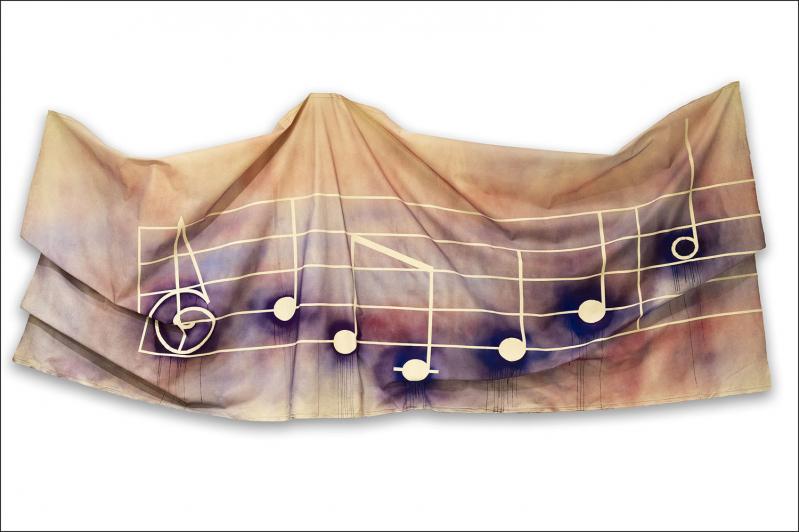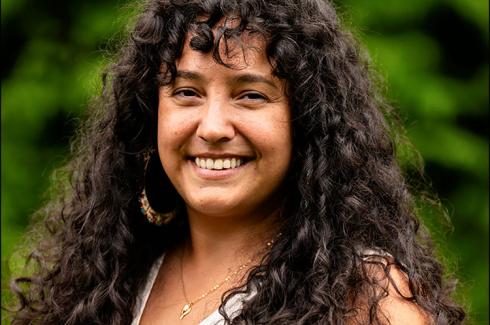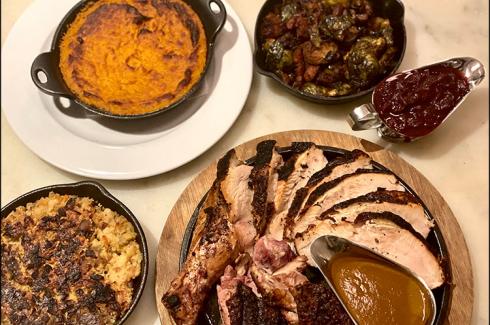“In the Out/Out the In,” the artist Nina Yankowitz’s first retrospective, opens Thursday at the Parrish Art Museum in Water Mill and will continue through Feb. 22. A reception will be held on Saturday at 6:30 p.m., followed by a talk with the artist and Corinne Erni, the museum’s chief curator.
Ms. Yankowitz, whose six-decade career has expanded the boundaries of painting, sculpture, sound, video, and installation, divides her time between SoHo and Sag Harbor. She came to prominence in the 1960s in New York City and graduated in 1969 from the School of Visual Arts. That same year she had her first solo show, at the Kornblee Gallery on East 69th Street.
The show included “Oh Say Can You See: A Draped Sound Painting,” in which she painted the first few notes of the national anthem on cloth, hung the cloth loosely on the gallery wall, and paired it with a recording of the notes. That piece, part of the Parrish exhibition, is typical of the artist’s approach to the technical possibilities of canvas, cardboard, paint sprayers, sound, and sewing equipment.
Ms. Yankowitz was selected for the Whitney Biennial in 1973, and soon after was a founding member of the Heresies Collective, a feminist group that gave rise to Heresies magazine, which called into question many of the practices and assumptions of the art world.
“I was never interested in having work that used ‘female’ imagery,” she told The Star in a 2014 interview. “But Heresies opened a lot of doors for disenfranchised artists, and I realized it was necessary to take one thing, in that case female imagery, and push it through in order to make a change.”
The retrospective, which was organized by the Museum of Fine Arts, St. Petersburg, Fla., traces the artist’s career through major series and landmark works, from early draped and pleated canvases to “Dilated Grain Readings” (1973-77), which translate synesthetic experiences into painted form.
Other highlights include “Lips Knees Neck Elbows Chest Rear” (1974), an audio piece; “Hell’s Breath” (1982), a monumental ceramic tile mural not seen since its debut at MoMA PS1; “Criss Crossing the Divine” (2016), an interactive meditation on world religions, and “Closing Bell” (2024), an installation commenting on climate change and migration crises, realized in collaboration with more than 30 artists, poets, and musicians.
“Nina Yankowitz has never stopped challenging the limits of artistic practice,” said Mónica Ramírez-Montagut, the museum’s executive director. “She is an artist whose work resists categories by symbolically weaving painting, sculpture, sound, performance, and technology in transformative ways. Nina’s commitment to inclusiveness and social justice has never wavered.”
Ms. Erni, who worked with Ms. Yankowitz during the museum’s “Artists Choose Parrish” exhibition, said she expects this show “to be no less invigorating, moving from her draped canvases to cantilevered works and interactive media pieces, as well as her brand-new collaborative installation addressing the climate crisis — always thinking about the times we live in, and always with a humorous touch.”
The exhibition was curated by Katherine Pill, senior curator of contemporary art at the Museum of Fine Arts, St. Petersburg. The Parrish show was organized by Ms. Erni with Scout Hutchinson, associate curator of exhibitions. It is accompanied by a fully illustrated catalog.
Tickets to Saturday’s opening and talk are $20, $18 for senior citizens, $10 for members’ guests, and free for members, resident benefits passholders, students, and children.
‘Fresh Paint’
Also opening Thursday at the Parrish is “Fresh Paint: Rudolf Stingel,” the latest in the rotating series of single-artwork shows presented in collaboration with the Flag Art Foundation.
Mr. Stingel is presenting “Untitled” (2025), a large-scale interactive installation, in the museum’s interior lobby. The piece is made from a series of Celotex panels — aluminum-faced foam insulation boards — that will cover the lobby’s eastern wall.
The metallic surface is malleable and receptive to pressure, and viewers are invited to leave marks and impressions of their own design upon the work, which will be on view through Feb. 2. Over time, in a collaboration between the artist and the museum’s visitors, it will gather layers of line, text, and image, referencing graffiti and drawing into wet cement.




